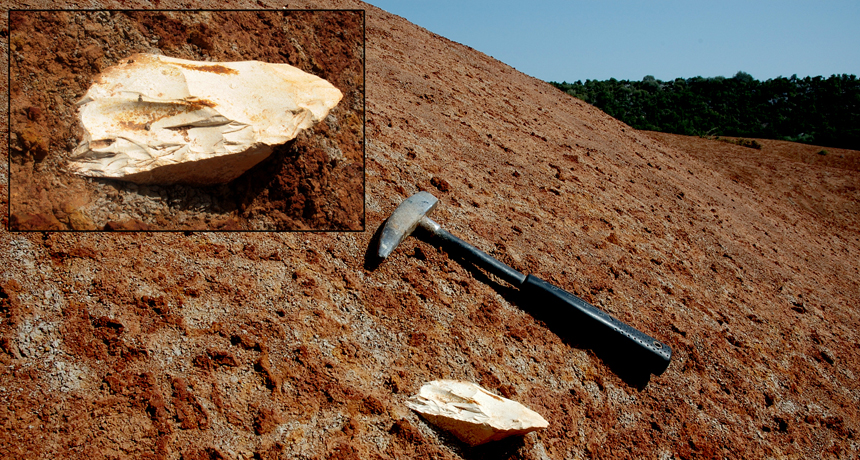Ancient hominids moved into Greece about 206,000 years ago
Dating of stone tools will help track Homo sapiens migration out of Africa

ROCK OF AGES A stone tool pokes out of sediment where it was recovered at Greece’s Kokkinopilos site. Also shown in the inset, this artifact comes from soil that dates to about 206,000 years ago, a new study finds.
Vangelis Tourloukis
ST. LOUIS — Greece has long been known as a bastion of research into a civilization that gave birth to democracy 2,500 years ago. Now, the country appears poised to become a key player in the study of European Neandertals and ancient human groups that entered Southeast Europe from Homo sapiens’ African birthplace.
New geological evidence from a Greek archaeological site indicates that hand axes and other stone artifacts previously unearthed from one soil layer date to about 206,000 years ago, says geoarchaeologist Vangelis Tourloukis of Eberhard Karls Universitӓt Tübingen in Germany. Stone implements from a higher sediment layer at the site, called Kokkinopilos, date to about 172,000 years ago, Tourloukis reported March 27 at the annual meeting of the American Association of Physical Anthropologists.
Neandertals and their ancestors inhabited Europe before 172,000 years ago. The new findings raise the possibility of dating later finds in Greece that can shed light on when humans first reached Europe, presumably sometime between 100,000 and 40,000 years ago.
Until now, tentative dates for a handful of Stone Age sites in Greece ranged from 130,000 to 40,000 years ago. Several of these sites have yielded Neandertal fossils. One site contains stone tools typically considered to be products of H. sapiens. Stone artifacts have also been found in two or more soil layers at two sites of uncertain age near Kokkinopilos, Tourloukis said.
The site contains the oldest archaeological material in Greece that comes from sediment dated with measurements of radioactive elements, says Tourloukis, who collaborated on the project with geoarchaeologists Panagiotis Karkanas of the American School of Classical Studies at Athens and Jakob Wallinga of Wageningen University in the Netherlands. Their paper will appear in an upcoming issue of the Journal of Archaeological Science.
Since the initial recovery of stone tools at Kokkinopilos in 1962, scientists have debated the age of the artifacts. At issue was whether water from an ancient lake adjacent to the site seeped into the soil and caused it to shift. Mixing of soil layers would greatly complicate efforts to estimate ages of recovered artifacts.
Surveys and soil analyses uncovered no evidence that sediment layers or artifacts at Kokkinopilos had shifted over time, Tourloukis said. The scientists measured the decay of radioactive elements in samples from three soil layers at Kokkinopilos. That data enabled them to estimate the time since those layers were buried and unexposed to sunlight. A soil layer above the two artifact-bearing deposits, which has not yielded stone tool finds, dates to about 156,000 years ago.
A handful of other proposed Stone Age sites in Greece can now be dated using the same approach, Tourloukis said.
New dates for Kokkinopilos begin to illuminate when hominids inhabited a region that has been little studied, remarked archaeologist Alison Brooks of George Washington University in Washington, D.C.
Paleoanthropologist Katerina Harvati, of Eberhard Karls Universitӓt Tübingen, agreed. “Southeast Europe, including Greece, was a likely route of human dispersal from Africa to Europe,” she said. Harvati directs ongoing excavations at hominid sites in Greece.
Editor’s note: This story was updated on April 2, 2015, to clarify a researcher’s comments in the fifth paragraph.







